Nevada, often termed the “Silver State”, is characterized by its vast deserts, rugged mountain ranges, and unique basin-and-range topography. The vast, contrasting landscapes of Nevada are not just a spectacle for the eyes but also a sanctuary for a remarkable variety of birds.
Among these feathered residents, the red birds stand out, displaying a vibrant hue that mirrors the fiery spirit of the Silver State. Dive into our guide as we spotlight 13 of these magnificent red aviators that grace Nevada’s skies, complete with a complimentary photo guide to enhance your birdwatching experience.
Red Birds Found In Nevada
Nevada’s geographical diversity, spanning from the arid expanse of the Mojave Desert to the snow-capped peaks of the Sierra Nevada Mountains, offers a myriad of habitats.
This range of environments, coupled with its strategic position along migratory paths, provides an abundance of niches for various bird species.
Northern Cardinal


| Feature | Measurement |
|---|---|
| Scientific Name | Cardinalis cardinalis |
| Length | 8.3 – 9.1 in |
| Wingspan | 9.8 – 12.2 in |
| Weight | 1.19 – 2.29 oz |
The Northern Cardinal is an iconic North American bird, easily recognized by its vibrant color and melodious song.
Appearance: Male Northern Cardinals are a brilliant scarlet red, while females display a more subdued reddish olive. Both sexes have a distinctive black ‘mask’ on their face around the bill and a pointed crest on their head. The bird’s beak is robust, cone-shaped, and bright orange in color.
Diet: Northern Cardinals are primarily granivorous, with a diet largely consisting of seeds and grains. They also eat fruits and insects. These birds typically feed off the ground and are frequent visitors to bird feeders.
Reproduction: Northern Cardinals are monogamous, and a pair will breed together for life. The female typically builds a well-hidden nest in a dense thicket or shrub. She lays 2-5 eggs per clutch, which she incubates for around two weeks.
Summer Tanager


| Feature | Measurement |
|---|---|
| Scientific Name | Piranga rubra |
| Length | 6.7 in |
| Wingspan | 28 to 30 cm |
| Weight | 29 g |
The Summer Tanager is a medium-sized songbird admired for its radiant plumage and melodious song.
Appearance: Male Summer Tanagers are an impressive bright red, while females and juveniles present a softer, yellow-orange color. Both genders have a large, slightly hooked bill and relatively short tail.
Diet: Summer Tanagers primarily feed on insects, including bees and wasps, which they catch in flight or pick off vegetation. They are also known to eat fruits and berries, making them helpful in controlling pest populations and seed dispersal.
Reproduction: The female Summer Tanager builds a loose, shallow cup-shaped nest out of twigs and grass, usually hidden in the foliage of trees. The female typically lays 3-5 eggs, which she will incubate for about two weeks.
Vermilion Flycatcher
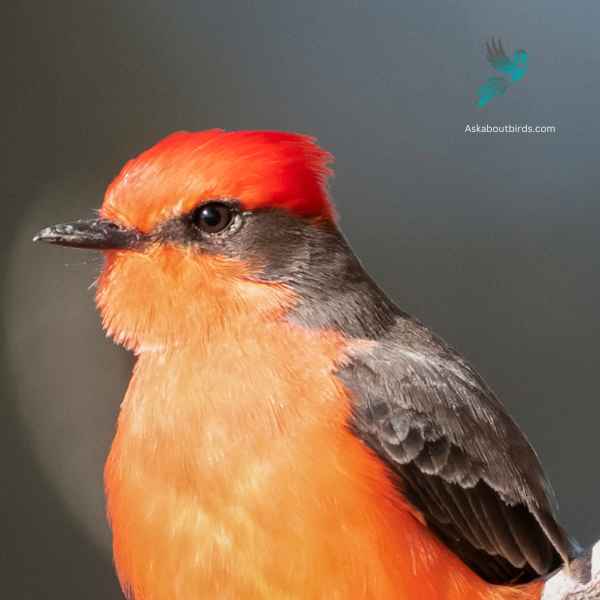

| Feature | Measurement |
|---|---|
| Scientific Name | Pyrocephalus obscurus |
| Length | 5.1–5.5 in |
| Wingspan | 9.4 to 9.8 in |
| Weight | 11 to 14 g |
The Vermilion Flycatcher is a small and colorful bird native to the Americas. The male Vermilion Flycatcher is a striking sight, displaying a vibrant red plumage on its head, breast, and underparts, contrasting with its brown wings and black tail below. Females, on the other hand, have more muted colors, featuring a pale yellowish belly and grayish-brown upperparts.
Vermilion Flycatchers are known for their lively and acrobatic flight displays, which they perform during courtship or to defend their territories. They often sing a series of soft, whistled notes while engaged in these aerial displays. They construct cup-shaped nests, usually in shrubs or low trees, where females lay their eggs and raise their young.
House Finch


| Feature | Measurement |
|---|---|
| Scientific Name | Haemorhous mexicanus |
| Length | 5–6 in |
| Wingspan | 8–10 in |
| Weight | 0.6–0.9 oz |
The House Finch is a small songbird widely distributed across North America and is commonly found in urban and suburban areas.
Appearance: Males of this species are brightly colored with crimson faces and throats, which can extend to the chest and back, while their flanks have streaks. The female is streaked brown and lacks the red coloring. Both have a square-tipped tail and a distinctively long, flat-topped bill.
Diet: House Finches primarily eat seeds, grains, and berries. They have a particular fondness for sunflower seeds and can be commonly seen at bird feeders. Occasionally, they will also consume insects, especially during the breeding season.
Reproduction: House Finches are cavity-nesters and might choose ledges, vents, ledges, and other urban settings. They might also utilize trees or shrubs. Their nests can be made of a wide array of materials, from feathers to twigs.
Cassin’s Finch

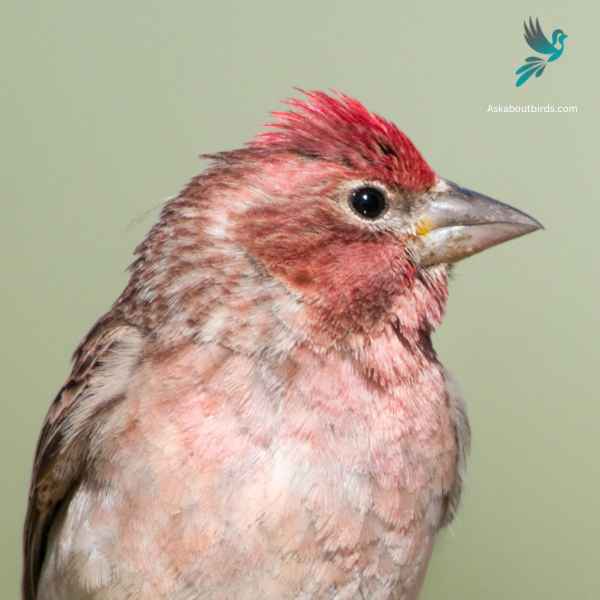
| Feature | Measurement |
|---|---|
| Scientific Name | Haemorhous cassinii |
| Length | 6.0-6.5 in |
| Wingspan | 9.5-10.5 in |
| Weight | 0.8-1.0 oz |
The Cassin’s Finch is a small songbird known for its melodic song and affinity for high-elevation forests.
Appearance: Male Cassin’s Finches are pinkish-red on the crown and throat, contrasting with their streaked brown back and wings. Females lack the bright coloring, appearing streaked brown throughout with a pale eyebrow stripe. Both sexes have a notched tail and a slightly curved bill.
Diet: Cassin’s Finches mainly feed on seeds, particularly from conifers. They also eat insects, especially during the breeding season. Their feeding habits often bring them to bird feeders where they readily eat sunflower seeds.
Reproduction: Cassin’s Finches nest in trees, preferring coniferous forests. The nest is made from twigs, grasses, and feathers. Typically, the female lays 3 to 5 eggs and handles most of the incubation. Both parents partake in feeding the fledglings once they hatch.
Red Crossbill

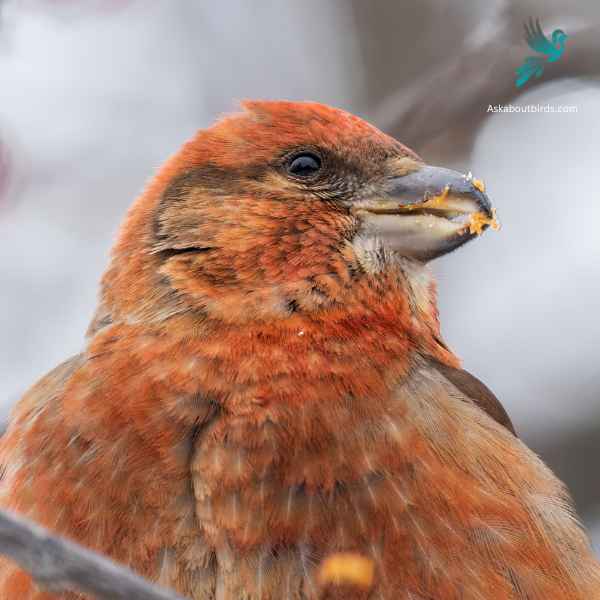
| Feature | Measurement |
|---|---|
| Scientific Name | Loxia curvirostra |
| Length | 5.5–7.5 in |
| Wingspan | 9.8–10.6 in |
| Weight | 0.9–1.4 oz |
The Red Crossbill is a distinctive finch known for its unusual bill, which has evolved to extract seeds from conifer cones.
Appearance: Males are typically bright red or orange, while females are greenish-yellow or olive. Both genders have the characteristic crossed bill, which they use to expertly extract seeds from tightly closed conifer cones.
Diet: Red Crossbills primarily feed on the seeds of coniferous trees, such as spruce, pine, and fir. Their specialized bills allow them to efficiently pry apart conifer cone scales to access the seeds.
Reproduction: Red Crossbills are somewhat nomadic and don’t adhere to a strict breeding schedule. Instead, they breed whenever and wherever food is abundant. Their nests are usually built on horizontal branches of conifer trees.
Pyrrhuloxia

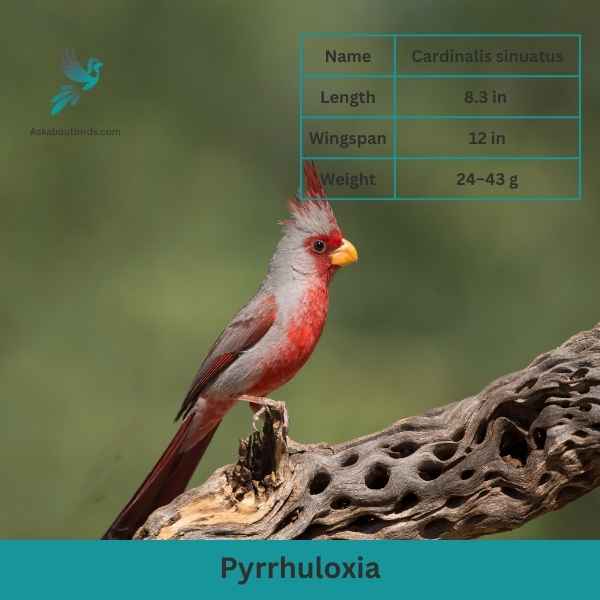
| Feature | Measurement |
|---|---|
| Scientific Name | Cardinalis sinuatus |
| Length | 8.3 in |
| Wingspan | 12 in |
| Weight | 24–43 g |
The Pyrrhuloxia, also known as the Desert Cardinal, is a medium-sized songbird native to the southwestern United States and northern Mexico. It is closely related to the Northern Cardinal but possesses its own unique characteristics. The Pyrrhuloxia is named after its vibrant red crest and mask-like face markings, similar to that of the Northern Cardinal. However, its overall coloration is more muted, with a grayish body and reddish wings and tail.
Pyrrhuloxias are known for their distinct vocalizations, which include a variety of songs and calls. Males often sing from elevated perches to defend their territories and attract mates. They also engage in aggressive displays to establish dominance.
Common Redpoll

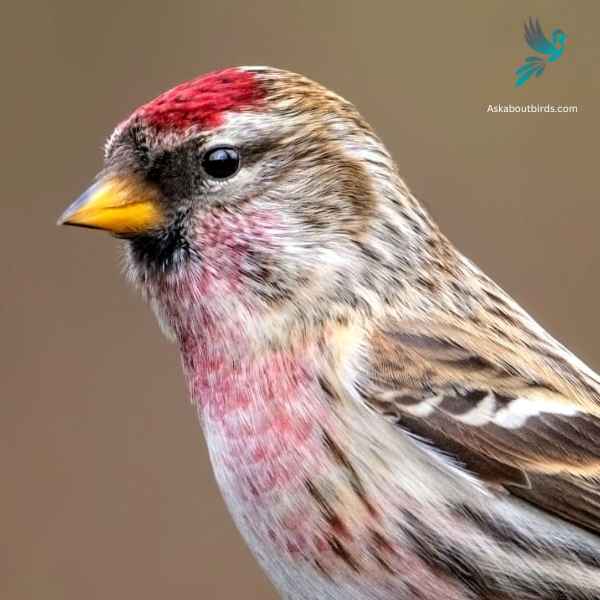
| Feature | Measurement |
|---|---|
| Scientific Name | Acanthis flammea |
| Length | 5.0-5.5 in |
| Wingspan | 7.5-8.5 in |
| Weight | 0.4-0.9 oz |
The Common Redpoll is a small songbird that is easily identifiable by its rosy-red forehead, black chin, and often fluttering flight pattern.
Appearance: Common Redpolls exhibit a distinctive rosy-red forehead patch and black chin. The males typically have a more extensive pink wash on their chest and face than females. The rest of their body is primarily streaked brown and white, with two white wing bars and a notched tail.
Diet: The diet of the Common Redpoll predominantly consists of seeds, particularly from birches and alders. They have a specialized throat pouch where they can temporarily store seeds, allowing them to consume them later in a more sheltered location.
Reproduction: Common Redpolls nest in shrubs or on the ground, using grasses, twigs, and feathers for construction. The female is responsible for the majority of the incubation and typically lays a clutch of 4 to 6 eggs. After the eggs hatch, both parents take part in feeding the young.
Pine Grosbeak

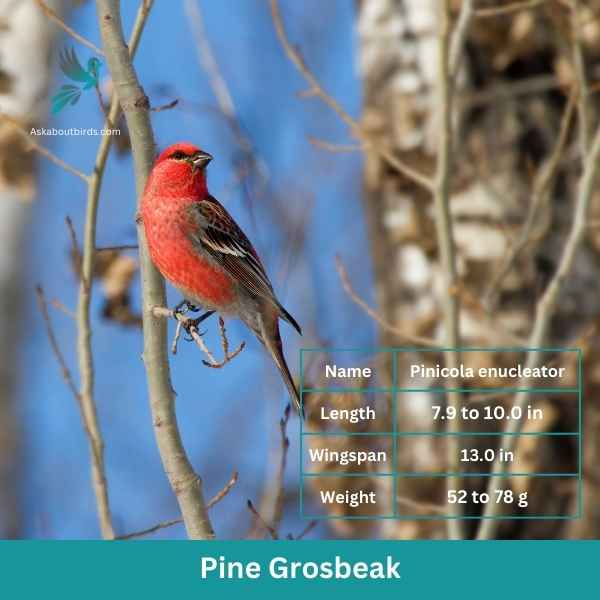
| Feature | Measurement |
|---|---|
| Scientific Name | Pinicola enucleator |
| Length | 7.9 to 10.0 in |
| Wingspan | 13.0 in |
| Weight | 52 to 78 g |
The Pine Grosbeak is a striking bird native to the northern regions of North America, often found in coniferous forests. Both males and females have a plump and robust body with a large beak adapted for eating seeds. The male Pine Grosbeak displays a vibrant reddish-pink plumage, while the female has a more subdued grayish-brown coloration.
These birds are typically seen in small flocks, foraging for food in trees and on the ground. They have a preference for seeds, particularly those from various conifer species. The Pine Grosbeak uses its strong bill to crack open the cones of tall trees and extract the seeds, but they also consume berries and small fruits when available.
Western Tanager

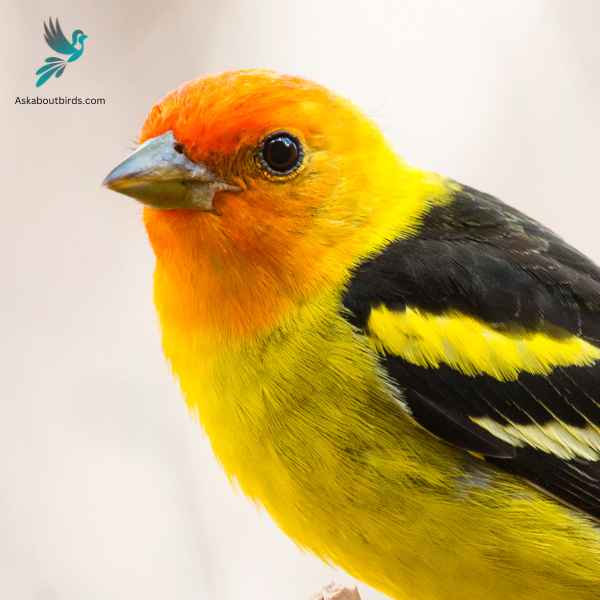
| Feature | Measurement |
|---|---|
| Scientific Name | Piranga ludoviciana |
| Length | 6.3-7.5 in |
| Wingspan | 11.5 in |
| Weight | 24-36 g |
The Western Tanager is a vibrant songbird that graces the forests and woodlands of the western regions of North America, enchanting observers with its colorful plumage and melodious song.
Appearance: The male Western Tanager is renowned for its bright yellow body contrasted with a striking red head and black wings and tail. The females are more subdued in hue, primarily being yellow with grayish wings and back, and lacking the brilliant red head of the males.
Diet: Western Tanagers primarily feed on insects, especially when breeding, but they also incorporate a significant amount of fruits and berries into their diet, especially during migration and winter.
Reproduction: Western Tanagers build their nests high in coniferous trees, often well concealed from potential predators. The female usually lays a clutch of 3 to 5 eggs and takes the primary role in incubation, while both parents are involved in feeding the chicks after they hatch.
Rufous Hummingbird


| Feature | Measurement |
|---|---|
| Scientific Name | Selasphorus rufus |
| Length | 3.1–3.9 in |
| Wingspan | 4.3 in |
| Weight | 0.1–0.2 oz |
The Rufous Hummingbird is a small, brilliantly colored bird known for its impressive migratory journeys and feisty behavior.
Appearance: The male Rufous Hummingbird boasts a gleaming orange-red body with a white chest and an iridescent red throat, called a gorget. The female has green upperparts with rufous-washed flanks and tail. Her throat may have some iridescent patches, but it’s generally whitish.
Diet: Like other hummingbirds, the Rufous Hummingbird primarily feeds on nectar from a variety of flowering plants. They also eat insects and spiders for protein, catching them in flight or plucking them from vegetation.
Reproduction: Rufous Hummingbirds nest in trees, shrubs, or even ferns. The female alone selects the site, builds the nest, and cares for the offspring.
Red-naped Sapsucker


| Feature | Measurement |
|---|---|
| Scientific Name | Sphyrapicus nuchalis |
| Length | 7.5-8.5 in |
| Wingspan | 16 in |
| Weight | 1.2-1.7 oz |
The Red-naped Sapsucker is a medium-sized woodpecker commonly found in forests across the western North America, especially in mixed coniferous woods and aspen groves.
Appearance: This woodpecker is distinguished by its black-and-white barred pattern on the back and wings. A key feature is the bright red patch on the back of the head, which gives the bird its name. Both sexes have a white stripe down the side of the face, though males have a red patch on the throat, whereas females have a white one.
Diet: Red-naped Sapsuckers are named for their habit of drilling rows of shallow holes into tree bark to feed on sap and the insects attracted to it. They also consume ants, beetles, and caterpillars, and will sometimes eat fruits and berries.
Reproduction: These woodpeckers excavate nest cavities in trees, often selecting dead or decaying trees or limbs. After carving out a cavity, the female typically lays a clutch of 4 to 7 eggs. Both parents share responsibilities for incubation and feeding the chicks once they hatch.
Red-breasted Sapsucker
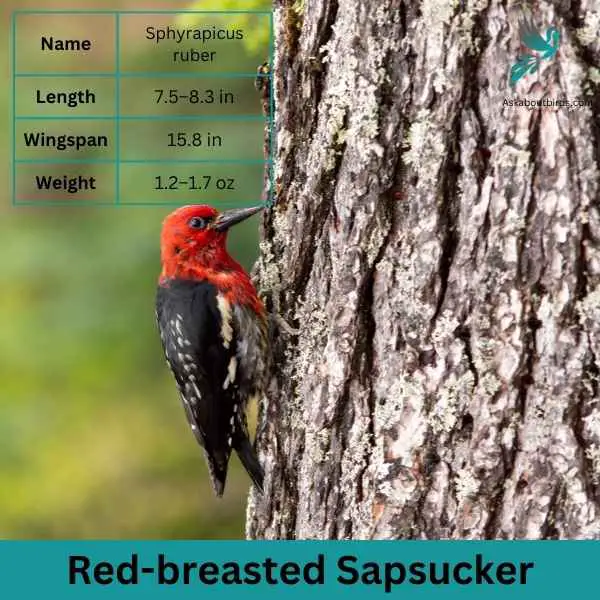
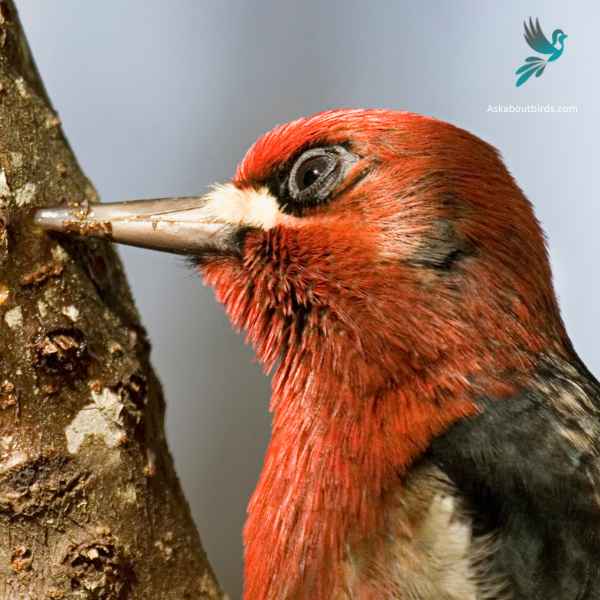
| Feature | Measurement |
|---|---|
| Scientific Name | Sphyrapicus ruber |
| Length | 7.5–8.3 in |
| Wingspan | 15.8 in |
| Weight | 1.2–1.7 oz |
The Red-breasted Sapsucker is a medium-sized woodpecker known for its vibrant coloration and distinctive foraging habits.
Appearance: This bird is primarily recognizable by its bright red head, breast, and flanks. The wings are black with white barring, and there’s a prominent white stripe running vertically down the wing. Its back is barred with black and white.
Diet: True to their name, Red-breasted Sapsuckers drill series of small holes in trees to feed on sap. They also consume insects attracted to this sap, as well as berries and fruits when available.
Reproduction: Red-breasted Sapsuckers create nest cavities in dead or decaying trees, and sometimes in living trees where the heartwood is decayed.
Where to Spot Nevada’s Red Birds
Nevada’s natural reserves and parks offer unparalleled birdwatching experiences, each with its unique avian treasures waiting to be discovered.
- Red Rock Canyon National Conservation Area: Just a short drive from Las Vegas, this area boasts stunning red rock formations and a diverse bird population, making it a haven for birdwatchers.
- Great Basin National Park: Situated in eastern Nevada, its varied elevations, from sagebrush to mountain peaks, offer a diverse habitat for a variety of birds, especially around the Lehman Caves area.
- Stillwater National Wildlife Refuge: Located in the heart of the Lahontan Valley, this refuge is especially known for its marsh habitats that attract both migratory and resident bird species.
- Ash Meadows National Wildlife Refuge: With its unique desert wetlands, this refuge near Death Valley is home to rare bird species and offers a stark contrast of blue waters against the desert backdrop.
- Humboldt-Toiyabe National Forest: Spanning a vast area of Nevada, this forest is home to several species of woodpeckers, finches, and other red birds, particularly around the Ruby Mountains and Spring Mountains regions.
| State’s Red Birds | Top Spots For Red Birds |
|---|---|
| California’s Red birds | 1. Point Reyes National Seashore 2. Salton Sea National Wildlife Refuge 3. Yosemite National Park |
| Oregon’s Red birds | 1. Malheur National Wildlife Refuge 2. Mount Hood National Forest 3. Cascade-Siskiyou National Monument |
| Idaho’s Red birds | 1. Camas National Wildlife Refuge 2. Sawtooth National Forest 3. Coeur d’Alene Lake |
| Utah’s Red birds | 1. Bear River Migratory Bird Refuge 2. Zion National Park 3. Bryce Canyon National Park |
| Arizona’s Red birds | 1. Chiricahua National Monument 2. Saguaro National Park 3. Havasu National Wildlife Refuge |
FAQs on Red Bird Species Found in Nevada
How do purple finches differ from other birds?
The purple finch, with its rosy pink head and distinctive brown coloring, stands out among other birds. Males possess a more profound hue, making them easily distinguishable from females, which lean towards a pale brown hue. Common in backyard feeders, especially those filled with black oil sunflower seeds, these birds visit from both northern and western states, as well as eastern and southern ones.
Why are sunflower seed feeders recommended for backyard birdwatching?
Sunflower seed feeders, especially those filled with black oil sunflower seeds, are magnets for various bird species. From tiny birds with yellow feathers to those with iridescent feathers or a sharp brown crest, these feeders provide ample opportunities to spot diverse species. Birds like the purple finch, with its unique rosy pink head, often frequent these backyard feeders, making birdwatching a delightful experience.
What birds are known for their bright blue heads?
Birds with bright blue heads are a visual treat and are relatively rare compared to other birds with brown coloring or green wings. While these birds might be native to various regions, including central and south America, spotting them outside their natural habitat might indicate them as accidental or rare species. Their vibrant coloration often makes them a favorite among bird enthusiasts.
Are white winged crossbills frequent visitors to backyards?
White winged crossbills, recognized by their distinctive tail feathers and darker wings, are more attuned to forest canopy and forest edges. They thrive in large flocks and primarily feast on conifer seeds. While they occasionally visit bird feeders, especially in northern and western states, their primary habitat includes dense vegetation, making them less common in typical backyards.





